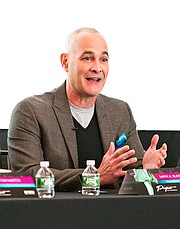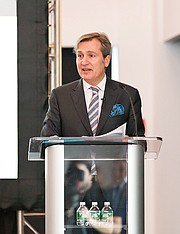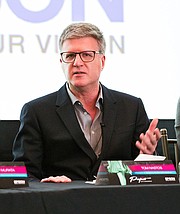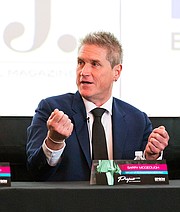TECHNOLOGY
Epson Panel Explores Tech’s Impact on Fashion
NEW YORK—Whether you’re a small startup designer or a long-established global brand, digital technology is becoming an ever more essential part of the fashion supply chain, industry experts agree.
A seven-member panel, convened by Epson to launch New York Fashion Week, brought together a diverse range of viewpoints from academia, event management, production and design.
“The time to replace analog with digital is now,” said Minoru Usui, president of Seiko Epson Corp., citing the “outstanding quality and great cost performance for small-lot production” that digital technologies, whether hardware or printing, can offer. Epson produces four categories of digital technology: inkjet printers, visual technology, wearable technology and robotics.
“We’re seeing a shift in the way design departments are keeping up with the consumer, thanks to social media driving instant gratification,” said Anthony Cenname, vice president and publisher of WSJ Magazine, who moderated the panel.
“What we’re looking at from a tech perspective is—how will technology affect us most? Both at retail and in terms of the customer experience,” said Barry McGeough, group vice president at PVH Innovation Next, the country’s second-largest apparel importer. While joking about the “iPhone-ization of our industry,” like “a drone showing up at your house with a bottle of Windex,” the challenges are very real, he said. Artificial intelligence and machine learning are becoming more-important tools, he said, citing companies such as StitchFix that are using AI successfully.
“Technology has affected every part of our business,” said independent designer Erin Fetherston, whose brand is 12 years old. “It’s rapidly accelerating the way we do business and consumers’ expectations. See-now, buy-now is where technology is our greatest aid.”
From initial online inspiration—which used to mean “going to the library to check out old issues of Vogue”—to final tweaks of finished apparel, technology affects all her work, she said.
“Technology has changed a lot of things,” agreed Paolo Crespi, commercial director of For.Tex, a leading company in the production of dyes, thickeners, and products for fabric pre- and post-treatment, based in Como, Italy, that is owned by Epson.
“People used to do four collections a year, and with digital it’s changed completely,” he said. “It used to take three to four weeks to produce a design and now it takes a few days. There’s no limitation on colors, for example.”
Digital technology allows for quick, short runs, said McGeough, allowing designers to make capsule collections. Customization “at the retail level is not novel any longer. That’s gone. That’s now table stakes.”
The ability to hyper-customize is more important than ever, agreed Fetherston. “I see the individual customer wanting more and more uniqueness. It feels like everyone wants a unique piece.” That means making fewer units, “the opposite of how you’d strategize manufacturing from a few years ago.”
Digital printing allows for much greater flexibility, said Assaf Ziv, creative director of Elie Tahari. “We can print on lace and sequins, making an illusion of 3D or 4D. For us, it’s essential. It’s a big tool.”
The industry also needs to focus more on R&D and make use of what it already knows, McGeough added.
“The data are floating around waiting for us to find it and use it,” he said. “Look for what people want by looking at the data you already have. Data analysis in fashion is a big job now. We were gently chided by Intel, who told us, ‘Wake up! You’re a data company.’ I would totally agree.”
Sustainable production is also aided by technology, he said. “If we can take the water process out, we can take out costs and speed up efficiency,” he said. “How do we compete with the H&Ms and Uniqlos of the world, who put out 26 seasons a year? We’re going to do that by being closer to the market by using robotics and automated processes. It’s all about lead-time optimization. How can we make our market more competitive? By focusing on speed, lower costs and reduced inventory.”
Having fiber created at needle “is very, very important,” he added. “That could be a really compelling proposition.”





























